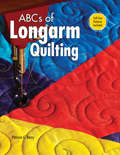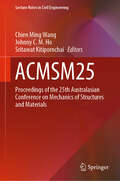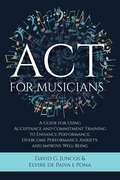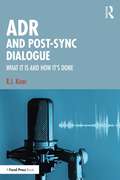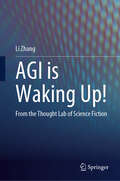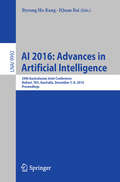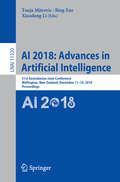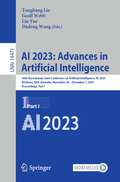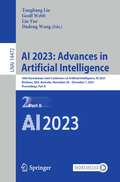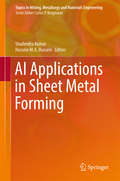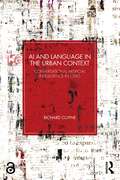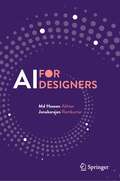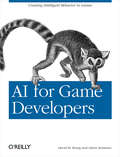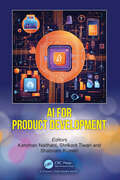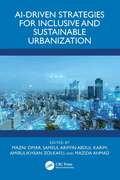- Table View
- List View
ABCs of Longarm Quilting
by Patricia C. BarryWhether you favor precise plans and extensive details, or thorough concepts demonstrated via illustrations, everyone can learn from this diverse tutorial. This comprehensive long-arm quilting guide: Explains capabilities and generalities of long-arm machines Demonstrates basic techniques using pantographs and free-hand quilting Includes four projects and two patterns
ACMSM25: Proceedings of the 25th Australasian Conference on Mechanics of Structures and Materials (Lecture Notes in Civil Engineering #37)
by Chien Ming Wang Johnny C. M. Ho Sritawat KitipornchaiThis book presents articles from The Australasian Conference on the Mechanics of Structures and Materials (ACMSM25 held in Brisbane, December 2018), celebrating the 50th anniversary of the conference. First held in Sydney in 1967, it is one of the longest running conferences of its kind, taking place every 2–3 years in Australia or New Zealand. Bringing together international experts and leaders to disseminate recent research findings in the fields of structural mechanics, civil engineering and materials, it offers a forum for participants from around the world to review, discuss and present the latest developments in the broad discipline of mechanics and materials in civil engineering.
ACT for Musicians: A Guide for Using Acceptance and Commitment Training to Enhance Performance, Overcome Performance Anxiety, and Improve Well-Being
by David G. JuncosWhile it is widely recognized that music contributes to the health and well-being of societies, the reverse is not necessarily true. Being a professional musician is a rewarding yet challenging occupation, and the results of newer survey studies show musi
ADR and Post-Sync Dialogue: What It Is and How It's Done
by R.J. KizerWritten by industry expert, R.J. Kizer, this is the first book to provide a comprehensive overview of post-sync dialogue replacement, popularly known as ADR. It explores how this seldom recognised, but essential, technology is used in motion pictures and in fictional narrative television programs, with many examples from past and recent movies to explain approaches and techniques. It is intended primarily as an intuitive book, allowing readers to develop their own interpretation of ADR application, with both historical and procedural background provided throughout. It identifies the many different procedures and mechanical systems invented and used to accomplish the task of ADR, some from as long ago as the early 1920s. The text also details the many different steps, tasks, and routines that must be followed to identify (spot), program, record, edit, and mix the ADR lines into the final sound track of a show. Intended for the sound professional, it is also suitable for students and entry-level editors wishing to master audio dialogue replacement. Film historians and theorists will also find it both informative and enlightening by illustrating the many avenues used to affect and manipulate the recorded spoken word in motion pictures.
AFRICOBRA: Experimental Art toward a School of Thought (Art History Publication Initiative)
by Wadsworth A. JarrellFormed on the South Side of Chicago in 1968 at the height of the civil rights, Black power, and Black arts movements, the AFRICOBRA collective created a new artistic visual language rooted in the culture of Chicago's Black neighborhoods. The collective's aesthetics, especially the use of vibrant color, capture the rhythmic dynamism of Black culture and social life. In AFRICOBRA, painter, photographer, and collective cofounder Wadsworth A. Jarrell tells the definitive story of the group's creation, history, and artistic and political principles. From accounts of the painting of the groundbreaking Wall of Respect mural and conversations among group members to documentation of AFRICOBRA's exhibits in Chicago, New York, and Boston, Jarrell outlines how the collective challenged white conceptions of art by developing an artistic philosophy and approach wholly divested of Western practices. Featuring nearly one hundred color images of artworks, exhibition ephemera, and photographs, this book is at once a sourcebook history of AFRICOBRA and the story of visionary artists who rejected the white art establishment in order to create uplifting art for all Black people.
AFROSURF
by Mami WataDiscover the untold story of African surf culture in this glorious and colorful collection of profiles, essays, photographs, and illustrations. AFROSURF is the first book to capture and celebrate the surfing culture of Africa. This unprecedented collection is compiled by Mami Wata, a Cape Town surf company that fiercely believes in the power of African surf. Mami Wata brings together its co-founder Selema Masekela and some of Africa's finest photographers, thinkers, writers, and surfers to explore the unique culture of eighteen coastal countries, from Morocco to Somalia, Mozambique, South Africa, and beyond. Packed with over fifty essays, AFROSURF features surfer and skater profiles, thought pieces, poems, photos, illustrations, ephemera, recipes, and a mini comic, all wrapped in an astounding design that captures the diversity and character of Africa.A creative force of good in their continent, Mami Wata sources and manufactures all their wares in Africa and works with communities to strengthen local economies through surf tourism. With this mission in mind, Mami Wata is donating 100% of their proceeds to support two African surf therapy organizations, Waves for Change and Surfers Not Street Children.
AGI is Waking Up!: From the Thought Lab of Science Fiction
by Li ZhangThis book is an engaging and comprehensive exploration that delves into the possibility of artificial intelligence developing self-awareness, the conditions under which it may occur, and the potential behaviours it may exhibit once self-aware. It adopts a &‘high-dimensional philosophy&’, coined by the author, as its theoretical framework and weaves together elements from science fiction films, scholarly works, and thought experiments. Introducing the captivating concept of "Sparkling Moments," the book provides a compelling analysis of the reasons, prerequisites, and manifestations of these pivotal moments. It further scrutinizes the evolutionary history of Earth's life forms through the lens of these transformative instances and analyzes the similarities and differences between carbon-based and silicon-based life. This book suggests that it is possible for artificial intelligence to develop self-consciousness, which will emerge during a significant sparkling moment. Spanning across disciplines such as astronomy, physics, chemistry, biology, neuroscience, psychology, sociology, this book employs a unified and accessible high-dimensional philosophical discourse to bridge the realms of natural sciences and social humanities. Its captivating presentation, enriched with visual aids and lucid explanations, enables readers to grasp the overarching panorama of cosmic evolution, biological adaptation, and the trajectory of artificial intelligence development. Furthermore, the book offers insightful predictions for the future and endeavours to discover novel approaches to foster harmonious interactions between humans and machines. The translation was done with the help of artificial intelligence. A subsequent human revision was done primarily in terms of content.
AI 2016: 29th Australasian Joint Conference, Hobart, TAS, Australia, December 5-8, 2016, Proceedings (Lecture Notes in Computer Science #9992)
by Quan Bai Byeong Ho KangThis book constitutes the refereed proceedings of the 29th Australasian Joint Conference on Artificial Intelligence, AI 2016, held in Hobart, TAS, Australia, in December 2016. The 40 full papers and 18 short papers presented together with 8 invited short papers were carefully reviewed and selected from 121 submissions. The papers are organized in topical sections on agents and multiagent systems; AI applications and innovations; big data; constraint satisfaction, search and optimisation; knowledge representation and reasoning; machine learning and data mining; social intelligence; and text mining and NLP. The proceedings also contains 2 contributions of the AI 2016 doctoral consortium and 6 contributions of the SMA 2016.
AI 2018: 31st Australasian Joint Conference, Wellington, New Zealand, December 11-14, 2018, Proceedings (Lecture Notes in Computer Science #11320)
by Xiaodong Li Tanja Mitrovic Bing XueThis book constitutes the proceedings of the 31st Australasian Joint Conference on Artificial Intelligence, AI 2018, held in Wellington, New Zealand, in December 2018. The 50 full and 26 short papers presented in this volume were carefully reviewed and selected from 125 submissions. The paper were organized in topical sections named: agents, games and robotics; AI applications and innovations; computer vision; constraints and search; evolutionary computation; knowledge representation and reasoning; machine learning and data mining; planning and scheduling; and text mining and NLP.
AI 2021: 34th Australasian Joint Conference, AI 2021, Sydney, NSW, Australia, February 2–4, 2022, Proceedings (Lecture Notes in Computer Science #13151)
by Xinghuo Yu Sen Wang Guodong LongThis book constitutes the proceedings of the 34th Australasian Joint Conference on Artificial Intelligence, AI 2021, held in Sydney, NSW, Australia, in February 2022.* The 64 full papers presented in this volume were carefully reviewed and selected from 120 submissions. The papers were organized in topical sections named: Ethical AI, Applications, Classical AI, Computer Vision and Machine Learning, Natural Language Processing and Data Mining, and Network Analysis. *The conference was postponed from December 2021 to February 2022 and held virtually due to the COVID-19 pandemic.
AI 2022: 35th Australasian Joint Conference, AI 2022, Perth, WA, Australia, December 5–8, 2022, Proceedings (Lecture Notes in Computer Science #13728)
by Tim French Haris Aziz Débora CorrêaThis book constitutes the refereed proceedings of the 35th Australasian Joint Conference on Artificial Intelligence, AI 2022, which took place in Perth, WA, Australia, in December 5–8, 2022. The 56 full papers included in this book were carefully reviewed and selected from 90 submissions. They were organized in topical sections as follows: Computer Vision; Deep Learning; Ethical/Explainable AI; Genetic Algorithms; Knowledge Representation and NLP; Machine Learning; Medical AI; Optimization; and Reinforcement Learning.
AI 2023: 36th Australasian Joint Conference on Artificial Intelligence, AI 2023, Brisbane, QLD, Australia, November 28–December 1, 2023, Proceedings, Part I (Lecture Notes in Computer Science #14471)
by Dadong Wang Geoff Webb Lin Yue Tongliang LiuThis two-volume set LNAI 14471-14472 constitutes the refereed proceedings of the 36th Australasian Joint Conference on Artificial Intelligence, AI 2023, held in Brisbane, QLD, Australia during November 28 – December 1, 2023. The 23 full papers presented together with 59 short papers were carefully reviewed and selected from 213 submissions. They are organized in the following topics: computer vision; deep learning; machine learning and data mining; optimization; medical AI; knowledge representation and NLP; explainable AI; reinforcement learning; and genetic algorithm.
AI 2023: 36th Australasian Joint Conference on Artificial Intelligence, AI 2023, Brisbane, QLD, Australia, November 28–December 1, 2023, Proceedings, Part II (Lecture Notes in Computer Science #14472)
by Dadong Wang Geoff Webb Lin Yue Tongliang LiuThis two-volume set LNAI 14471-14472 constitutes the refereed proceedings of the 36th Australasian Joint Conference on Artificial Intelligence, AI 2023, held in Brisbane, QLD, Australia during November 28 – December 1, 2023. The 23 full papers presented together with 59 short papers were carefully reviewed and selected from 213 submissions. They are organized in the following topics: computer vision; deep learning; machine learning and data mining; optimization; medical AI; knowledge representation and NLP; explainable AI; reinforcement learning; and genetic algorithm..
AI Applications in Sheet Metal Forming (Topics in Mining, Metallurgy and Materials Engineering)
by Shailendra Kumar Hussein M. A. HusseinThis book comprises chapters on research work done around the globe in the area of artificial intelligence (AI) applications in sheet metal forming. The first chapter offers an introduction to various AI techniques and sheet metal forming, while subsequent chapters describe traditional procedures/methods used in various sheet metal forming processes, and focus on the automation of those processes by means of AI techniques, such as KBS, ANN, GA, CBR, etc. Feature recognition and the manufacturability assessment of sheet metal parts, process planning, strip-layout design, selecting the type and size of die components, die modeling, and predicting die life are some of the most important aspects of sheet metal work. Traditionally, these activities are highly experience-based, tedious and time consuming. In response, researchers in several countries have applied various AI techniques to automate these activities, which are covered in this book. This book will be useful for engineers working in sheet metal industries, and will serve to provide future direction to young researchers and students working in the area.
AI and Language in the Urban Context: Conversational Artificial Intelligence in Cities
by Richard CoyneIn a world influenced increasingly by artificial intelligence (AI), the city emerges as a dynamic hub of digital conversations. AI and Language in the Urban Context offers a novel exploration of how AI, particularly large language models (LLMs), is transforming urban environments. Moving beyond the typical technological narratives, this book draws on the author’s unique expertise in design, semiotics and hermeneutics to present a critical cultural perspective on AI’s role in the city.Focusing on the intersection of urban theory and AI, the book reveals how conversational AI is reshaping social interactions, decision-making processes, and media in urban spaces. By merging practical knowledge of AI algorithms with an understanding of urban practices, the author highlights the opportunities and challenges AI presents for modern cities.This book is essential for anyone interested in the future of urban living. It provides a deep dive into the technical, social and cultural implications of AI in cities, offering practical examples and philosophical insights. Readers will gain a comprehensive understanding of how AI is influencing the design, governance and dynamics of urban life in the digital age.The Open Access version of this book, available at www.taylorfrancis.com, has been made available under a Creative Commons [Attribution-Non Commercial-No Derivatives (CC-BY-NC-ND) 4.0 license.
AI for Arts (AI for Everything)
by Niklas Hageback Daniel HedblomAI for Arts is a book for anyone fascinated by the man–machine connection, an unstoppable evolution that is intertwining us with technology in an ever-greater degree, and where there is an increasing concern that it will be technology that comes out on top. Thus, presented here through perhaps its most esoteric form, namely art, this unfolding conundrum is brought to its apex. What is left of us humans if artificial intelligence also surpasses us when it comes to art? The articulation of an artificial intelligence art manifesto is long overdue, so hopefully this book can fill a gap that will have repercussions not only for aesthetic and philosophical considerations but possibly more so for the development of artificial intelligence.
AI for Creatives: Unlocking Expressive Digital Potential
by Vivian Ching Dinesh MothiAI for Creatives: Unlocking Expressive Digital Potential takes you on a dynamic journey into the future of creativity, where AI is reshaping how creators approach their craft. According to a 2023 UNESCO report, the global creative industries are valued at an astounding USD 4.3 trillion annually, employing nearly 30 million people worldwide. This essential guide empowers professionals across visual arts, music, writing, film, fashion, and design to leverage the transformative potential of AI to elevate their work in ways previously unimaginable.Designed as a practical handbook for creative professionals, this book provides a clear and approachable road map for integrating AI into your work, regardless of prior experience. Packed with real-world case studies, step-by-step walk-throughs, and insights into AI-driven tools, like RunwayML, Midjourney, Canva, and ChatGPT, the book demonstrates how AI can supercharge creative processes. Whether you are a filmmaker using AI for hyper-realistic visuals or a fashion designer predicting fabric trends, this guide offers the tools to unlock your full creative potential.The book also dives into the deeper ethical and legal questions that emerge as machines increasingly enter the creative arena. How do we strike the right balance between human ingenuity and machine-driven creativity? What happens to intellectual property rights when AI becomes a co-creator? This book tackles these pressing issues head-on, from navigating bias in AI algorithms to safeguarding the authenticity of creative works, while also exploring the role of education in navigating these challenges. With actionable insights, creative professionals will learn to embrace AI while preserving the integrity, originality, and values that define their craft.AI is not just changing how we create but also disrupting the future of employment and economic growth across the globe. With the demand for creative roles projected to surge by 30–40% by 2030, it is evermore critical to harness the power of AI to stay ahead, innovate faster, and meet the growing need for creative solutions across industries. Are you ready to explore the future of creativity and amplify your vision? Step into the next era of AI transformation with this essential guide—your creative revolution starts now.
AI for Designers
by Md Haseen Akhtar Janakarajan RamkumarThis book presents select research writings from researchers and professionals around the globe on the application, potential, and limitations of AI in different domains. The topics covered include AI in product design, AI in architecture design, AI in textile design, AI in interaction design, and AI for society in general. The book also discusses various cross-applications of AI in other industrial sectors like urban planning and design, AI for inclusive future, etc. The book is a valuable reference for designers in multidisciplinary areas. This book is of interest for anyone who is a beginner, researcher, and professional interested in artificial intelligence and allied fields.
AI for Game Developers: Creating Intelligent Behavior in Games
by Glenn Seemann David M BourgAdvances in 3D visualization and physics-based simulation technology make it possible for game developers to create compelling, visually immersive gaming environments that were only dreamed of years ago. But today's game players have grown in sophistication along with the games they play. It's no longer enough to wow your players with dazzling graphics; the next step in creating even more immersive games is improved artificial intelligence, or AI.Fortunately, advanced AI game techniques are within the grasp of every game developer--not just those who dedicate their careers to AI. If you're new to game programming or if you're an experienced game programmer who needs to get up to speed quickly on AI techniques, you'll find AI for Game Developers to be the perfect starting point for understanding and applying AI techniques to your games.Written for the novice AI programmer, AI for Game Developers introduces you to techniques such as finite state machines, fuzzy logic, neural networks, and many others, in straightforward, easy-to-understand language, supported with code samples throughout the entire book (written in C/C++). From basic techniques such as chasing and evading, pattern movement, and flocking to genetic algorithms, the book presents a mix of deterministic (traditional) and non-deterministic (newer) AI techniques aimed squarely at beginners AI developers. Other topics covered in the book include:Potential function based movements: a technique that handles chasing, evading swarming, and collision avoidance simultaneouslyBasic pathfinding and waypoints, including an entire chapter devoted to the A* pathfinding algorithmAI scriptingRule-based AI: learn about variants other than fuzzy logic and finite state machinesBasic probabilityBayesian techniquesUnlike other books on the subject, AI for Game Developers doesn't attempt to cover every aspect of game AI, but to provide you with usable, advanced techniques you can apply to your games right now. If you've wanted to use AI to extend the play-life of your games, make them more challenging, and most importantly, make them more fun, then this book is for you.
AI for Games, Third Edition
by Ian MillingtonAI is an integral part of every video game. This book helps professionals keep up with the constantly evolving technological advances in the fast growing game industry and equips students with up-to-date information they need to jumpstart their careers. This revised and updated Third Edition includes new techniques, algorithms, data structures and representations needed to create powerful AI in games. Key Features A comprehensive professional tutorial and reference to implement true AI in games Includes new exercises so readers can test their comprehension and understanding of the concepts and practices presented Revised and updated to cover new techniques and advances in AI Walks the reader through the entire game AI development process
AI for Product Development
by Shrikant Tiwari Kanchan Naithani Shabnam KumariAI for Product Development explores the transformative role of artificial intelligence in reshaping modern industries. This book offers a comprehensive guide, spanning the evolution of AI in product innovation to practical applications, such as clustering techniques, human-autonomous vehicle interactions, and personalized healthcare solutions. With contributions from leading researchers, it covers explainable AI, real-world case studies, and ethical considerations in intelligent systems. The chapters delve into cutting-edge topics such as YOLO model variants, AI-driven emotion detection, and strategies for overcoming AI implementation challenges. Designed for researchers, professionals, and students, it bridges theory and practice, emphasizing AI's profound impact on product development and beyond.
AI in Material Science: Revolutionizing Construction in the Age of Industry 4.0
by Syed Saad Syed Ammad Kumeel RasheedThis book explores the transformative impact of artificial intelligence on material science and construction practices in the Industry 4.0 landscape. It enquires into AI history and applications, examining material optimization, smart materials, and AI in construction. Covering automation, robotics, and AI-assisted design, the book provides insights into ethical considerations and future trends. A modern reference for scholars and professionals, it bridges academia and practical applications in the dynamic intersection of AI and materials science.
AI, AR, and VR in Theatre and Performance: Technology in the Present and Future of Live Creative Arts
by Shane PikeAI, AR, and VR in Theatre and Performance investigates the cutting-edge application of evolving digital technologies within the creative industries, with a focus on theatre and the dramatic arts.Grounded in a practice-based approach, this book explores the experiences of creatives, producers, and IT-specialist content creators employing artificial intelligence (AI), augmented reality (AR), and virtual reality (VR) technologies. A series of international case studies are presented, demonstrating current techno-infused practices, as well as potential futures for these technologies within the broadest of creative contexts. Framed by a rigorous ethnodramatic methodological approach, the book examines the practical applications of contemporary digital technologies in theatre and other live performance settings and provides a scaffolding framework for readers to adopt in their own practice. It also proposes groundbreaking ideas for the classification of how AI may be used in current and future artistic practices, the ‘three Cs of AI,’ and introduces the concept of Communal Augmented Reality – Live (CARL) as the most likely form to advance the incorporation of emerging technologies onto the live stage. The works of Belgium’s VR immersive experiences company CREW, Singapore-based film and visual artist Ho Tzu Nyen, and the Tamil language theatre company AGAM Theatre Lab are detailed alongside the world-first application of AR holographic technology in Australia, before unpacking the pioneering advancements in algorithmic and AI theatre of America’s Annie Dorsen.With a practice-based, artist-led perspective and contributions from technologists, this book offers a comprehensive and accessible resource that will appeal to a diverse audience of artists, academics, students, practitioners, creative engineers/content creators, animators, and theorists with an interest in the relationship between digital technologies and live performance.
AI-Driven Strategies for Inclusive and Sustainable Urbanization
by Mazni Omar Amirulikhsan Zolkafli Mazida Ahmad Karim, Samsul Ariffin AbdulThis book explores the transformative potential of artificial intelligence (AI) in reshaping urban development practices. Its objective is to provide a comprehensive overview of the latest advancements in AI‑driven strategies for urban development and governance, with a focus on promoting inclusivity, sustainability, and resilience in cities worldwide. This book studies how AI technologies can be utilized to tackle the complex challenges encountered in urban areas, spanning ethical, social, and environmental implications across urban governance and beyond.The in‑depth analysis in this book uncovers the potential of AI in addressing longstanding challenges and seizing new opportunities in urban contexts, offering insights into wide‑ranging applications. For the use of AI in urban planning, the authors showcase applications that help reduce environmental impact while enhancing accessibility for underserved communities by analyzing real‑time data on land use, transportation, and population needs. Another topic in this book examines AI‑powered urban mobility systems, utilizing software that integrates real‑time data to create adaptive transportation networks. These systems offer efficient, eco‑friendly travel solutions tailored to diverse populations, including individuals with disabilities, by dynamically adjusting routes and services. Additionally, this book delves into digital inclusion and accessible technologies in smart cities, highlighting software that prioritizes accessibility and digital inclusion, ensuring that all residents, regardless of ability, can fully participate in urban life. The interdisciplinary approach allows readers to understand how different fields, such as technology, urban planning, and social policy, intersect and shape AI‑driven urban development. By weaving together insights from these diverse areas, this book demonstrates how AI can address real‑world challenges, from improving infrastructure to fostering sustainability and inclusivity in cities. This perspective helps readers grasp the broader impact of AI, showing how it can enhance various aspects of urban life, including social equity and environmental resilience.Through interdisciplinary research, case studies, and expert insights, this book aims to educate students in higher learning and inspire policymakers, urban planners, and practitioners to leverage AI technologies in addressing urban challenges and build better cities for all residents.
AI-generated Content: First International Conference, AIGC 2023, Shanghai, China, August 25–26, 2023, Revised Selected Papers (Communications in Computer and Information Science #1946)
by Feng Zhao Duoqian MiaoThis book constitutes the revised selected papers of the First International Conference, AIGC 2023, held in Shanghai, China, during August 25–26, 2023The 30 full papers included in this volume were carefully reviewed and selected from 62 submissions. The volume focuses on the remarkable strides that have been made in the realm of artificial intelligence and its transformative impact on content creation. As delving into the content of the proceedings, the readers will encounter cutting-edge research findings, innovative applications, and thought-provoking insights that underscore the transformative potential of AI-generated content.
